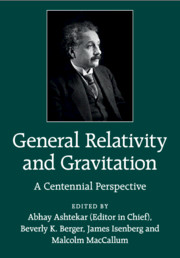Book contents
- Frontmatter
- Contents
- Preface
- List of contributors
- List of figures
- List of tables
- Part One Einstein's Triumph
- Part Two New Window on the Universe: Gravitational Waves
- 5 Receiving Gravitational Waves
- 6 Sources of Gravitational Waves: Theory and Observations
- Part Three Gravity is Geometry, after all
- Part Four Beyond Einstein
- Index
- References
5 - Receiving Gravitational Waves
from Part Two - New Window on the Universe: Gravitational Waves
Published online by Cambridge University Press: 05 June 2015
- Frontmatter
- Contents
- Preface
- List of contributors
- List of figures
- List of tables
- Part One Einstein's Triumph
- Part Two New Window on the Universe: Gravitational Waves
- 5 Receiving Gravitational Waves
- 6 Sources of Gravitational Waves: Theory and Observations
- Part Three Gravity is Geometry, after all
- Part Four Beyond Einstein
- Index
- References
Summary
Introduction
Gravitational waves are a consequence of Einstein's General Theory of Relativity, first presented in 1915 and published in 1916 [1]. Einstein himself linearized his theory and derived wave equations and calculated the gravitational radiation produced by sources in the weak-field, slow-motion limit [2]. As described in the following Chapter, this initial insight has been greatly expanded so that, in general, it is possible to calculate either numerically or analytically the details of the gravitational radiation for a broad range of potential astronomical sources. Much later, in the 1970s, the discovery of the binary neutron star system PSR1913+16 by Hulse and Taylor [3] demonstrated through this natural experiment that gravitational waves carry away energy and angular momentum, causing the neutron star orbit to decay at precisely the predicted rate. Early cosmological gravitational waves imprint a polarization signature in the electromagnetic microwave background that several sensitive instruments may detect. See [4] but also [5] and references therein for further discussion.
These brief remarks gloss over a more complex history where it was unclear whether gravitational waves were real or just gauge artifacts. The theory was finally settled on the side of reality [6]. The standard next step in physics – to build a receiver to directly detect gravitational waves – proved to be extremely challenging. The analog of the Hertz experiment where artificially generated waves are detected within the wave zone will fail because of the undetectably small amplitude (see for example [7]). Astrophysical sources are much stronger but are, of course, more distant. Yet their detection may be possible because gravitational wave receivers respond to amplitude and not to intensity. Nonetheless, the numbers are daunting.
In the early 1960s, J. Weber followed through on a bold vision – that gravitational waves were detectable – by measuring the resonant excitation of acoustic modes in heavy metallic bars, as would be caused by a passing gravitational wave from relatively nearby astrophysical sources [8].
- Type
- Chapter
- Information
- General Relativity and GravitationA Centennial Perspective, pp. 242 - 286Publisher: Cambridge University PressPrint publication year: 2015



